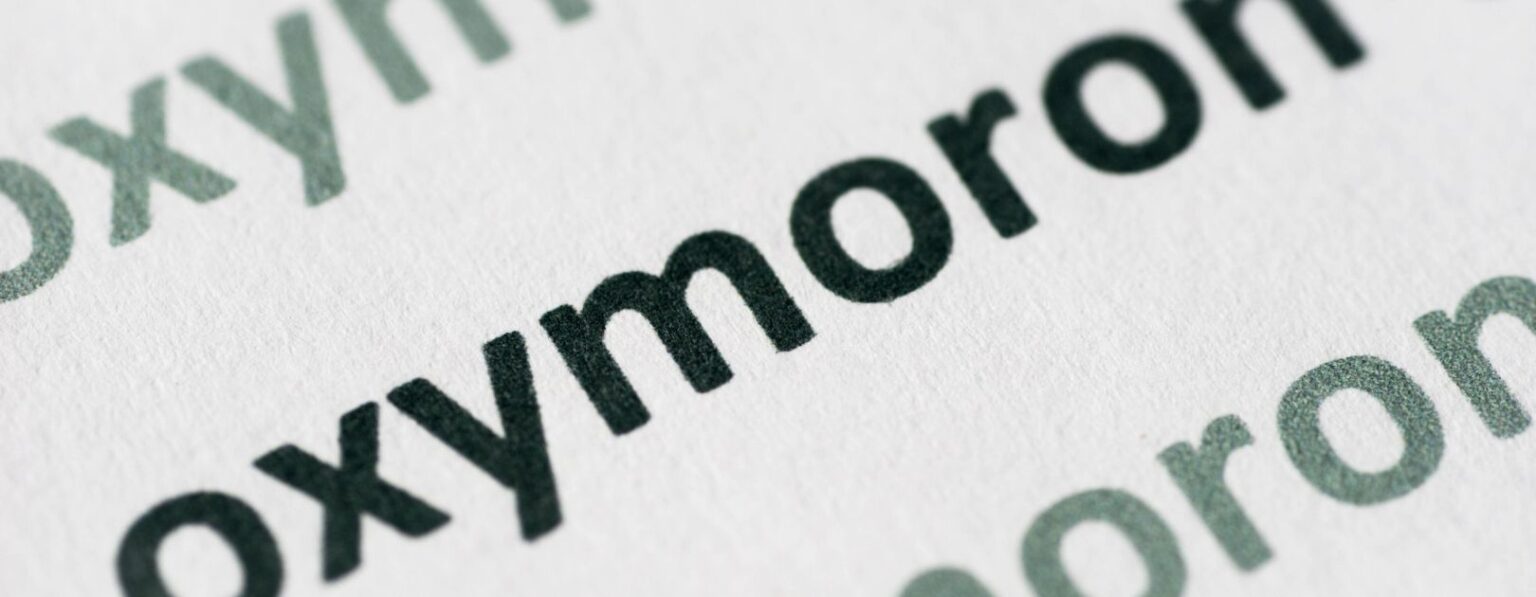Is there something pretty ugly? Yes, there is an oxymoron. Oxymoron means a phrase that uses contradictory terms to express a particular thought or sentiment.
We generally use these phrases in everyday language but aren’t aware of the contradiction that comes along, such as liquid gas, original copies, etc.
If we go by the literal meaning of these phrases, it seems to be contradictory, right? Think about how something can be pretty and ugly at the same time? Or how originals can be treated as copies?
That’s what oxymoron words are not a literal meaning, but a figurative language.
Examples:
You look awfully pretty in this gown.
Here, the speaker means that the person wearing a gown looks pretty.
The combination of these contradicting words unwraps a paradox, confusion, or gives the reader a laugh. So, the above example conveys that an oxymoronic sentence adds up an emotion or enhances the mood of a passage.
The interesting fact about oxymoron is about how it is derived. The term “oxymoron” is itself an oxymoron as it derives from the Greek “Oxus” (sharp) and “Moros” (stupid).
Though oxymoron is the most commonly used combination of opposite words, it is sometimes confused with paradox.
An example of a paradox is Truth is honey, which is bitter.
Here, honey and bitter both are used in the same sentence which has opposite meanings, but it’s not an oxymoron, it’s a paradox.
Read further to find out the line of difference between oxymoron and paradox.
Difference Between Oxymoron and Paradox
Oxymoron meaning says it’s a figurative language that uses opposite words in a sentence with no deep meaning, such as
I watched the play last night. It was seriously funny.
Here, the sentence means that the play was funny.
When we talk about paradox, it can have a sentence or group of sentences with contradicting words but illustrating underlying truth, such as
She saves money by spending it.
Here, the sentence means if she will spend her money putting some aside will reduce heating bills. So, that’s true if you spend and analyze your spending, it will help in your savings.
Hence, an oxymoron is paradoxical but is a figure of speech rather than a situation or event.
Oxymoron Examples
- It’s an open secret around the college that they fought.
Here, the sentence means that the fight was known by all students in the college, but no one talks about it.
- You were seriously funny throughout the act.
Here, the sentence means that the person acted funny in his act.
- The book store down the road has original copies of marvel comics.
Here, the sentence means that the store has the first originally printed marvel comics.
Similarly, the combinations of two contradicting words known are:
- Tragic comedy
- Foolish wisdom
- Liquid gas
- Cruel kindness
- Living death
Examples of Oxymoron in Literature
Oxymoron figure of speech when used properly, provides a writer to add characterization or emotion or dramatic effects to a passage through the contradiction of two words. Depicting these powerful insights here are some examples:
- Lancelot and Elaine (By Alfred Lord Tennyson)
The shackles of love straiten’d him
His honour rooted in dishonoured stood
And faith unfaithful kept him falsely true
The phrases “shackles… straiten’d,” “honour… dishonor,” “faith unfaithful,” and “falsely true” are oxymorons.
- Petrarch’s 134th sonnet (By Sir Thomas Wyatt)
I find no peace, and all my war is done
I fear and hope, I burn and freeze like ice,
I flee above the wind, yet can I not arise;
The contradicting words “war … peace,” “burn … freeze,” and “flee above … not rise” are oxymoron phrases.
Function of Oxymoron
As mentioned above, an oxymoron sentence provides a dramatic effect in a passage, be it prose or poetry. A writer will be able to emphasize a particular emotion or characterization through oxymoron phrases.
For example, “sweet sorrow” crafted by Shakespeare appeals to its readers instantly, making them think about the meaning of these two opposite words. However, this expresses a feeling of both positive and negative aspects.
The Importance of Using Oxymoron
Oxymorons are widely and commonly used in daily language, to add effects and humor in conversation. When used in literature such as speeches, poetry, etc it provokes the listeners to think about what is being said and how the two contradicting words make sense, such as sweet sorrow, crafted by Shakespeare.
Other examples are:
- Plastic glasses
- Escaped prisoners
- Deliberate mistakes
- Bittersweet


